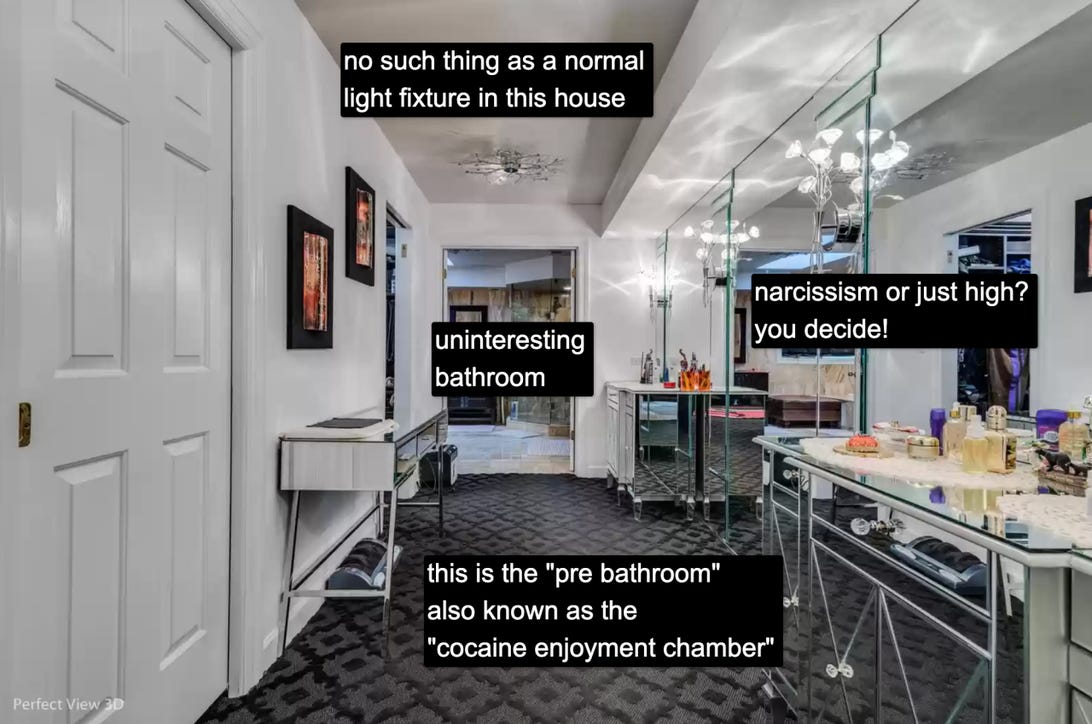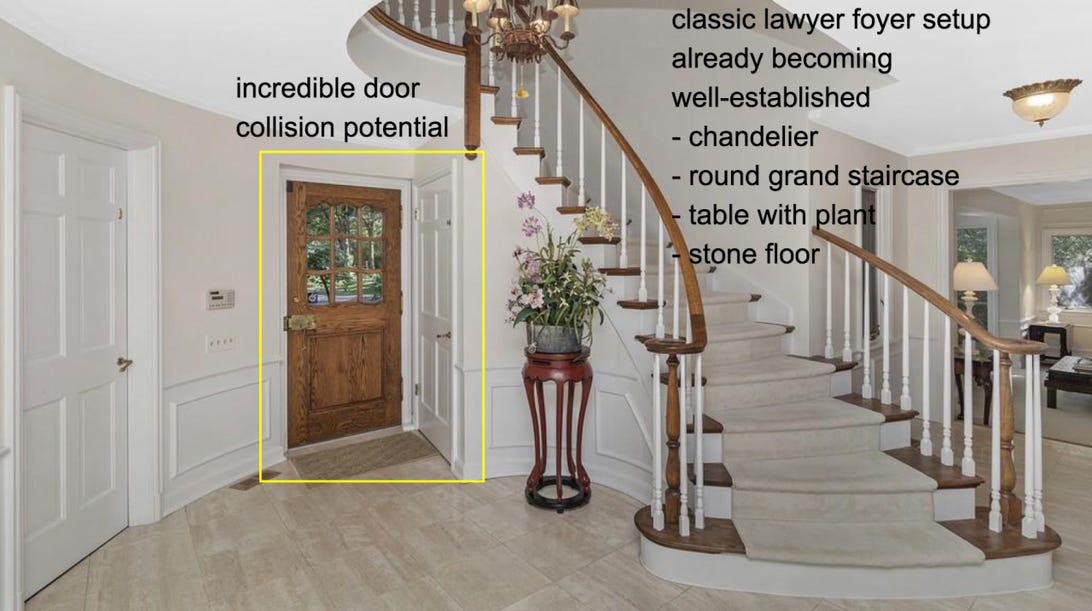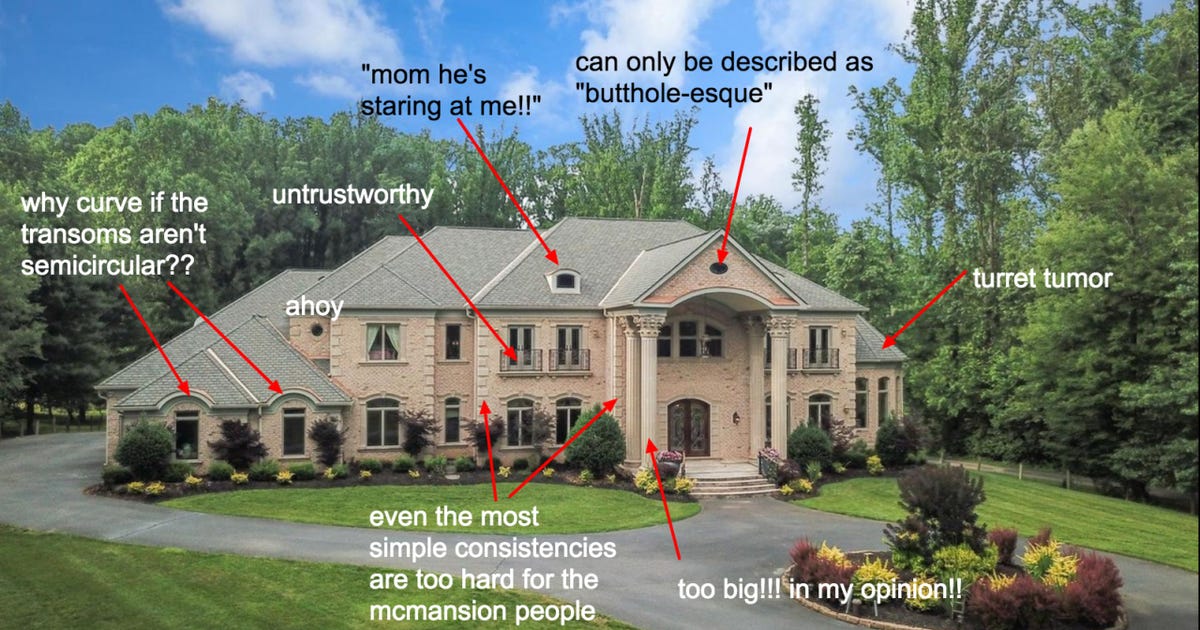Perhaps you’re into a perfectly preserved midcentury modern home with a sparkling swimming pool in the Palm Springs desert. Or you’re fascinated by a sprawling McMansion with cathedral ceilings and a front door you could drive a truck through. Or maybe, let’s just pretend, you actually like a vintage 1970s bedroom with a mirrored ceiling and a gold shag carpet.
Whatever you love in a house, there’s a huge world for you beyond endless episodes of House Hunters and housing sites like Zillow and Trulia. There’s also a dedicated online community passionate about real estate, architecture or both who spend hours finding the most bizarre, incredible and horrifying homes in America and delivering them to their thousands of followers.
Some, like the social media accounts Zillow Gone Wild and Cheapo Crappy Architecture are mostly about domestic window shopping, while others, like the blog McMansion Hell, take a deeper and more purposeful tone. But no matter their mission, they rank alongside adorable animal content as an enjoyable corner of an internet dominated by distressing headlines and Twitter-borne sniping.

This house in the Chicago suburbs is prime fodder for McMansion Hell.
McMansion Hell
For Kate Wagner, a writer and architecture critic who created McMansion Hell in 2016, the desire to see inside a stranger’s home comes from both interest and envy. “I think people like to look at real estate listings out of one a sense of voyeurism to see how other people live,” she says. “There’s also this desire for something that for many people is unattainable. To get angry at the people who truly have and will always have, I think drives McMansion Hell, even if there’s lots of other elements to it.”
Wagner couldn’t have started McMansion Hell at a better time. Though the US real estate market was booming long before COVID-19, the pandemic’s onset pushed it through the stratosphere as buyers took advantage of shuttered offices to relocate. Nationwide home sales in July jumped 23% over the same month in 2020, according to real estate brokerage Redfin, sparking bidding wars and pushing prices out of reach for many. But even rising mortgage rates can’t dent interest in the online sport of viewing and judging houses. McMansion Hell and Zillow Gone Wild approach this pastime from different sides, but both encourage their fans to do the same thing. Go ahead, gawk at the exterior and virtually walk through the rooms and absolutely critique a stranger’s taste.
Samir Mezrahi says he started Zillow Gone Wild in December 2020, at the height of the buying frenzy, after realizing he couldn’t be the only person browsing Zillow listings when he was bored. Now with almost 180,000 Twitter followers, he admits he got lucky with the timing.
“The account really tapped into the casual person who looks at real estate whether they’re looking to move or not,” he says. “Peeking into people’s homes and people’s places, I think there’s something interesting and entertaining about it.”
What makes a McMansion
There’s certainly no shortage of entertainment on McMansion Hell, which Wagner dedicates to skewering the most garish structures of suburbia. Though there’s no textbook definition of a McMansion, Wagner listed the hallmarks of these houses “everyone loves to hate” both on her blog and in a 2017 TedTalk. Picture an oversized (typically more than 3,000 square feet) multilevel home designed in a mishmash of styles (maybe a Tudor-style roof over a Colonial porch) and with a complete disregard for such basic architectural principles as balance or rhythm. Superficial features like decorative columns, an overly-elaborate entry and a randomly placed turret are meant to show the occupant’s wealth, but they can’t hide the home’s shoddy and mass-produced construction.
“All of these things are combined together to form this thing that’s really easy to dislike,” she told the Washington Post in a 2017 interview. “Because it’s pretentious.”
Wagner started following McMansions while growing up in North Carolina during the latter half of the McMansion building period, which she says lasted from about 1980 through the Great Recession. She combined her lifelong interest in architecture with serious thought about what the monstrous and often tacky homes represented.
“If it was only that I hated them, I probably wouldn’t be [writing the blog],” she says. “But I think they’re fascinating … I’ve always been interested in the McMansion and how it’s changed over the years in aesthetics, interior design and what people saw as desirable in a single family home.”

Nothing in a McMansion is safe from Wagner’s commentary
McMansion Hell
The blog really took off after an essay she wrote on what makes a home a McMansion went viral. Tumblr’s image-driven format was a natural first place for McMansion Hell in an era before Substack, and the platform still brings the majority of her readers. She now counts 100,000 Tumblr followers while also publishing to Facebook and Instagram and garners support for her work through Patreon.
Cates Holderness, the head of editorial at Tumblr, confirmed McMansion Hell is one of the site’s more popular blogs. “[Tumblr] tends to be a very highly visual platform, and I think with McMansion Hell specifically, Kate does a really great job of utilizing the tools it offers,” she says. “The photos are always high quality and her writing style has a ton of personality. That’s why it resonates with her followers and why the blog is so big.”
Punditry with a purpose
Wherever you read it, the blog is instantly engaging. Using photos plucked from real estate listings (the Chicago suburbs and Texas are fertile McMansion grounds), Wagner adds comments about the home’s exterior features and interior design. Hardly anything, from fake stucco walls to grandiose staircases and a gilded Putin-sized dining room table, escapes Wagner’s careful eye and sharp wit. Though always snarky, her commentary is never outright nasty, and it all comes grounded in good intentions.
“McMansion Hell is about explaining why these houses are terrible,” she says. “It’s not just that they are terrible, because they are, but being able to point to why, I think, is very important. That element of pointing out what does and doesn’t work was always there.”
Wagner, who writes all of the commentary herself, has even developed her own lingo to describe McMansions. A lawyer foyer is a massive entryway often with a drooping chandelier. A car hole is the door on a (typically three-car) garage. A cocaine enjoyment chamber is a 1980s-era bathroom with mirrored walls. And if she can’t explain something, like a window that doesn’t appear to have a room behind it, she’ll simply ask, “What’s this?”
She says she’s never heard from owners of the homes she’s featured, though she occasionally hears from real estate agents who’ve admitted the properties are difficult to sell. Instead, readers who grew up in McMansions are more likely to get in touch. Beyond finding the blog funny, they identify with the subtle commentary of alienation and rampant consumerism that underlines every post.
“A lot of the jokes about suburban isolation actually track,” she says. “It’s all very familiar while using extraordinary houses and bringing them into sort of a broader critique of just the way that we live, especially in America. It’s a critique of wealth and a critique of excess.”

Know your lawyer foyers.
McMansion Hell
But Wagner hasn’t always won fans. In 2017, Zillow demanded she stop using the site’s photos while accusing her of copyright infringement and violating federal anti-hacking laws. Though Wagner took down the blog for a couple of days, Zillow dropped legal action after the Electronic Frontier Foundation stepped in to defend her.
Corynne McSherry, the EFF’s legal director, says Zillow’s claims were unfounded. By annotating the photos, Wagner was protected under fair use grounds.
“We want to be especially vigilant around abusing intellectual property laws to try to shut down speech that’s clearly lawful,” McSherry says. “It’s really important when people can stand up and fight back. It helps other people know that they have options and they don’t have to just cave to a giant company that tried to threaten them.”
Zillow didn’t respond to multiple requests for comment.
Though she specialized in architectural acoustics in graduate school and is a published architecture critic, Wagner isn’t a trained architect herself. Still, she further pushes the blog’s strong educational component through articles on topics like proper window and roof design and an explainer on postmodernism. Her goal is to encourage readers to be more literate in architecture and demystify an often-rarefied world.
“I hope [readers] will learn about buildings. And I hope I encourage people to listen to their inner architecture critic and have the tools to make judgments on the built environment,” she says. “The point is to make architecture accessible for everybody and to make it fun, interesting and clever.”
Going wild on real estate
Sometimes, though, you just want to look at photos of quirky houses for sale, which is the whole point of Zillow Gone Wild. The homes Mezrahi features on the account don’t stick to a specific style. They can be big or small, luxurious or modest, modern or traditional. His goal is to maintain a positive tone regardless.
“I hope I’ve never been mean to anyone’s home,” he says. “These are people’s spaces with memories and collections, so I stay away from a hoarder house or someone who’s had tough times. But for a very rich person who had some bad design decisions, I think it’s more like a celebration of what someone’s home looks like.”
Besides Twitter, which he says gives the most creative freedom and the best engagement, Mezrahi also posts to Instagram (1.5 million followers) and Facebook (900,000 followers) and publishes a Substack newsletter. His format is simple: a link to the Zillow listing, which surfaces the photos, and the details like the price, square footage and number of bedrooms/bathrooms. His commentary is limited to a few words – like “this home has big NOPE energy” – or even emojis.
He says the account blew up after a February 2021 Saturday Night Live skit that parodied Zillow’s reputation as an addictive place for “real estate porn.” “Real estate is your sex now, and our listings are just standing by waiting for you to browse them,” a lingerie-clad Heidi Gardner croons while lying on a bed.
With millions of homes across the US and Canada, Zillow has more than enough material to keep Mezrahi busy, though he doesn’t have strict search criteria for finding the showstoppers. He finds many himself and picks from listing suggestions from followers (he typically gets between 50 and 100 submissions per day).
“Sometimes from the outside, you can see [a home] is going to be interesting,” he says. “And sometimes there’s one specific room [like a bathroom with a Jeff Goldblum shower curtain] that has something crazy, interesting or fun.”
A house for everyone
Scrolling through Mezrahi’s feed reveals a staggering array of options. There’s a David Bowie-themed swimming pool, an interior with spectacular carpets, several castle-themed homes, an underground palace (a listing Wagner also featured), a house that’s a converted train car, a basement with a dance floor and stripper pole and a property fit for the Flintstones. He’s also featured estates owned by celebrities, like Betty White’s Carmel, California, home, and those dedicated to celebrities, like a Houston townhouse with a decor themed on the sitcom Friends.
Houses with libraries or mirrors are especially popular with his followers, as are time capsules like a midcentury modern house with period furniture (a Florida midcentury design Mezrahi featured two weeks ago was his first post to get more than 100,000 Twitter likes). As he’s curated the account and responded to what resonates, Mezrahi says even his own tastes have changed.
“There’s just so many possibilities for what really takes off,” he says. “I’ve been radicalized because I wouldn’t have loved an untouched midcentury [home] three years ago. But now when I see one of them, I think, ‘This is amazing!'”
Sometimes a property is a hit for completely different reasons. In April, Mezrahi featured a home in Fairfax, Virginia, with “person(s) living in [the] lower level with no lease in place” (the house sold regardless of its many deficiencies). Then there was a house in Onalaska, Wisconsin, that didn’t look noteworthy until you got to the bedroom and saw the “Welcome to Poundtown” sign above the bed. The post from last month now has 60,000 Twitter likes, and Zillow Gone Wild’s exposure quickly made the home go viral on local and international media.
“The homeowners were so excited,” Mezrahi says. “I didn’t know that a Poundtown sign would come into my inbox, so it’s always fun.”
This $420k (lol) Onalaska, WI is a good example of what happens when your Michael’s obsession goes one sign too far pic.twitter.com/aBDPZ0VnQY
— Zillow Gone Wild 🏡 (@zillowgonewild) April 18, 2022
The attention the house received certainly surprised Spencer Hegenbarth, the real agent who listed it (the property is now in contract). “I just found it funny and a little crazy,” he said through a text conversation. “The sign was funny, and it’s my brother’s and sister-in-law’s sense of humor. I didn’t expect it to get passed around the US the way it did.”
Mezrahi says he’s only received positive feedback from homeowners and real estate agents. And as the account has grown, he suspects some people are photographing their home with the intent of being noticed. Why else, for example, would you put an inflatable alien in every room?
“From what I’ve gauged, it’s just more exposure and people seeing the home,” he says. “If [a home] has a weird room, it has a weird room. There’s nothing wrong with amplifying it and bringing more eyeballs to it.”
That attention has brought results. Vintage clothing business owner Emily O’Brien was immediately drawn to a stunning Rolling Meadows, Illinois, home in February after she saw it on Zillow Gone Wild’s Instagram. Though she wasn’t even set on buying a home while contemplating moving to the Midwest from Oakland, California, she booked a flight to Chicago and made an offer within a few days.
“I was definitely surprised that I found a house,” she says. “I’m not one of those people who browse Zillow or Redfin or whatever in their spare time. [Zillow Gone Wild] was one of the only house accounts that I follow just because I love the quirky houses. … It was definitely a serendipitous moment.”
Lou Zucaro, the agent who sold the home, says he had offers before Mezrahi featured the home, but none of them resulted in a closing. “It’s always nice to see one of my listings featured somewhere, including on [Zillow Gone Wild].”
End of an era
There are some signs that the real estate craze in some regions of the country is now cooling even if the median home price is still 17% higher than it was a year ago and inflation is at a historic level. But no matter what happens, sites like Zillow will continue to have plenty of home candy for Mezrahi to highlight. Mezrahi says he plans to stick to his proven formula for the time being and perhaps add a video component. Ultimately, though, it’s all about the fun.
“I hope I’m bringing joy to people’s day, an escape from their problems or the bad things that are going on, or even bringing people together,” he says. “Maybe I’ll even help people find their home or forever home.”
Wagner also tracks home design trends and says it’s increasingly hard to find McMansions with original interiors. Instead, as they’re put on sale the McMansions are renovated – or as she puts it, “HGTV-ified” – with white walls and generic furniture.
“It’s really a shame because the character of the house is just completely erased,” she says. “I know real estate agents do that because they want people to picture their own lives in their house, but for those of us who are interested in architecture, it’s quite disappointing.”
She recognizes that since McMansions are now rarely built, the material for her blog will dwindle. But that won’t stop her from always being fascinated by the homes, their vulgarity and what they represent.
“The McMansion still is a symbol of the American dream or whatever, but it’s no longer sort of representational,” she says. “I don’t think we’ll ever go back to that level of insanity.”
https://www.cnet.com/news/social-media/dont-just-tour-that-home-online-by-all-means-judge-it/
You may also like
-
Amazon is selling a ton of these cheap things make your backyard so much better
-
Your Guide to Westfield, New Jersey, by The Giordano Group
-
Out of New Bedford Chaos Came Robert’s Rules of Order
-
Isle of Lewis: Croft house in Stornoway named Scotland’s Home of the Year 2022
-
Traditional croft house in Stornoway crowned Scotland’s Home Of The Year 2022

